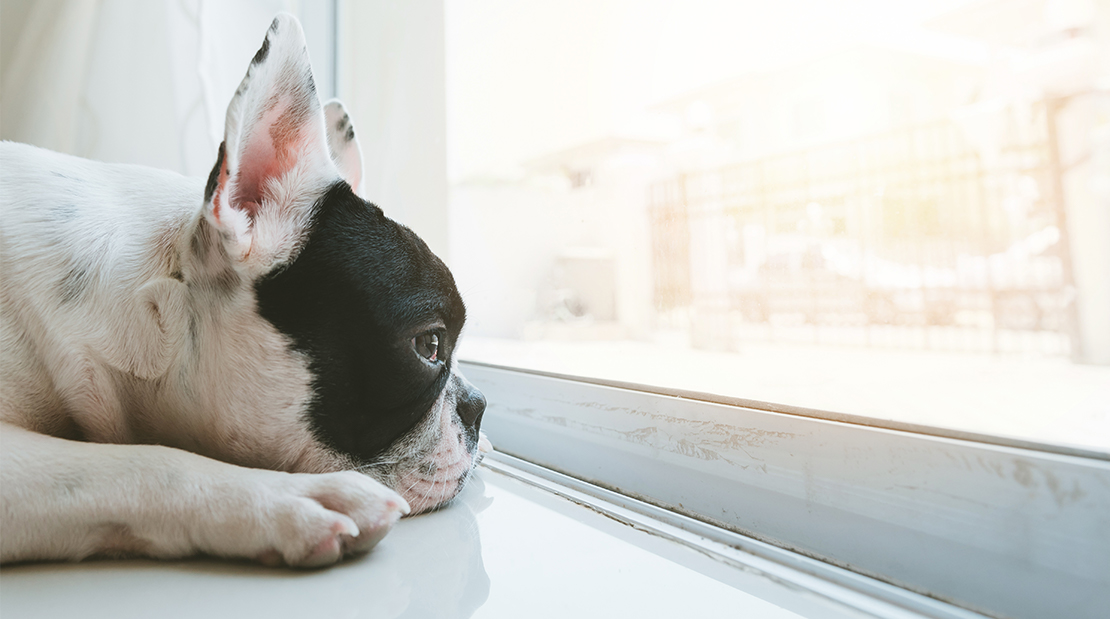
Signs of Pet Anxiety
As the old saying goes, every dog has its day. However, if your dog seems to have days that are more down than up, your companion may be suffering from anxiety or depression. At its core, anxiety is a blend of feeling some combination of nervous, fearful, and/or uncertain. These feelings can be triggered by a myriad of underlying causes and should be addressed as early as possible.
Like us, dogs can experience periods of anxiety or depression when trying to cope with significant life changes. Perhaps your pet has lost a close housemate or caregiver, or maybe he or she has been spending an increasing amount of time alone. These changes can cause a shift in your pal’s routine, and can ultimately affect your dog’s quality of life and emotional wellbeing. It’s important to remember that man’s best friend requires the same amount of love, attention, and affection they provide to their owners.
The first step in treating your dog’s anxiety is recognizing when they are exhibiting early warning signs. Here are some common indicators and remedies for anxiety or depression in dogs:
Your dog won’t stop singing the Blues
Occasional whimpering from your dog is normal, but consistent crying is a sign of anxiety. First, pay close attention to when your dog is weeping. If your dog seems to cry excessively when you leave the home, he or she may be suffering from separation anxiety. There are a few remedies, like anxiety medication, that can help your dog cope with your absence. Pheromone collars and sprays can also be an effective recourse. Be sure to discuss these options with your vet to determine what’s best for your dog.
Also, ask yourself if your dog is getting enough companionship and interaction throughout the day. If not, your dog’s separation from you may intensify its feelings of boredom, and even loneliness. An alternative to leaving your dog at home for extended amounts of time is enrolling him or her in doggy daycare. The right daycare center can help alleviate your dog’s sense of loneliness, and keep them active and healthy.
If daycare is not an option, consider spending more quality time with your dog when you are together. Your simple presence may not be enough if your dog has been isolated for extended periods of time. Be sure to incorporate lots of playtime and one-on-one attention. Last but not least, arrange play dates with other dog owners. Play dates with other dogs are a great way to provide companionship, while also improving social skills.
Your dog has become destructive
Dogs that are experiencing anxiety may start to become destructive or lash out. Don’t be so quick to punish your dog for perceived bad behavior. Often, this destructiveness can be a result of your dog’s prolonged confinement in tight spaces, such as kennels or small rooms. Chewing on or breaking out of kennels, and destroying furniture are top indicators that something is wrong.
Try comforting your dog with special attention during these periods of anxiety, and avoid leaving him or her in confined spaces for more than 8 hours at a time. If kennels are necessary, be sure that the correct size is being used to hold your furry friend. By rule of thumb, dogs should be able to stand, turn, sit and lay comfortably in a properly sized kennel. Owners who have to routinely leave their dogs in confined spaces should consider using a dog service, such as mid-day dog walkers.
Your dog is exhibiting excessive panting, salivation, and trembling
These types of behavior are common with anxiety associated with large crowds, thunderstorms, and other high stress environments. Pay attention to your dog’s behavior in large crowds, such as festivals or concerts. Trembling and panting are signs that your dog is uncomfortable in the environment and may do better with smaller crowds. Try to slowly introduce your dog into large social environments for short periods of time. As time goes on, your dog should become more comfortable with these types of engagements.
Dogs can show signs of thunderstorm anxiety before we even know a storm is coming. Try physical reassurance such as petting and holding to reduce nervousness.
A dog’s emotional wellbeing is an important factor in its quality of life. Dogs that suffer from depression can lose interest in normal physical activities, which can lead to weight gain and associated health risks. Anxiety can lead to a dog’s behavioral changes that can become harmful to itself, and can ultimately affect its interaction with other dogs or humans. The good news is, your dog’s anxiety or depression doesn’t have to last forever. With our tips, and of course, a discussion with your vet, your dog can be back to its cheerful self in no time.

